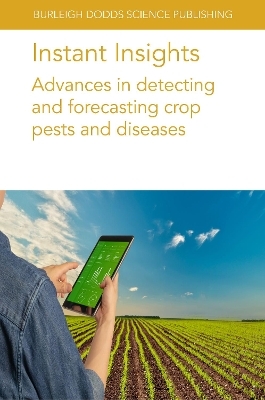
Instant Insights: Advances in Detecting and Forecasting Crop Pests and Diseases
Burleigh Dodds Science Publishing Limited (Verlag)
978-1-80146-506-9 (ISBN)
This collection features six peer-reviewed reviews on advances and in detecting and forecasting crop pests and diseases.
The first chapter introduces the concept of machine learning to identify and diagnose crop diseases, focussing on the deep learning concept.
The second chapter discusses recent advances in crop disease forecasting models, focussing on the application of precision agriculture technologies and Earth observation satellites to identify areas at risk of possible disease outbreaks.
The third chapter explores the contribution of remote sensing in improving the ways in which plant health is monitored in response to exposure to biotic stresses, such as disease.
The fourth chapter reviews how sensor technologies in combination with informatics and modern application technologies can contribute to more effective pest control.
The fifth chapter assesses the role of decision support systems for pest monitoring and management through information technology, such as spectral indices and image-based diagnostics.
The final chapter addresses key issues and challenges in pest monitoring and forecasting models, such as the limitation of some traps in attracting insects through the use of sex pheromones.
Chapter 1 - Using machine learning to identify and diagnose crop diseases: Megan Long, John Innes Centre, UK; 1 Introduction 2 A quick introduction to deep learning 3 Preparation of data for deep learning experiments 4 Crop disease classification 5 Different visualisation techniques 6 Hyperspectral imaging for early disease detection 7 Case study: Identification and classification of diseases on wheat 8 Conclusion and future trends 9 Where to look for more information 10 References
Chapter 2 - Advances in crop disease forecasting models: Nathaniel Newlands, Summerland Research and Development Centre, Science and Technology Branch, Agriculture and Agri-Food Canada, Canada; 1 Introduction 2 Modeling complex, crop-disease-environment dynamics 3 Big data assimilation to improve forecast quality 4 Novel artificial intelligence (AI)-based methodologies 5 Case study: operational, crop disease early-warning systems 6 Conclusion and future trends 7 Where to look for further information 8 References
Chapter 3 - Advances in remote/aerial sensing technologies to assess crop health: Michael Schirmann, Leibniz Institute of Agricultural Engineering, Germany; 1 Introduction 2 Remote sensing of crop health 3 Remote sensing of crop diseases 4 Case study: detecting stripe rust using very high-resolution imaging 5 Conclusion and future trends 6 Where to look for further information 7 References
Chapter 4 - Precision crop protection systems: E. C. Oerke, University of Bonn, Germany; 1 Introduction 2 Variability of pest incidence and pest management strategies 3 Sensor use for disease management 4 Sensor use for the management of invertebrate pests 5 Perspectives 6 References
Chapter 5 - Decision-support systems for pest monitoring and management: B. Sailaja, Ch. Padmavathi, D. Krishnaveni, G. Katti, D. Subrahmanyam, M. S. Prasad, S. Gayatri and S. R. Voleti, ICAR-Indian Institute of Rice Research, India; 1 Introduction 2 Pest identification 3 Pest monitoring 4 Pest forecasting 5 Integrated pest management (IPM) 6 Case studies 7 Summary and future trends 8 Where to look for further information 9 References
Chapter 6 - Advances in insect pest and disease monitoring and forecasting in horticulture: Irene Vänninen, Natural Resources Institute Finland (LUKE), Finland; 1 Introduction 2 Addressing key issues and challenges of pest monitoring and forecasting 3 Case study: whitefly sampling, monitoring and forecasting
4 Conclusion 5 Future trends in research 6 Where to look for further information 7 References
| Erscheinungsdatum | 12.05.2023 |
|---|---|
| Reihe/Serie | Burleigh Dodds Science: Instant Insights |
| Zusatzinfo | Color tables, photos and figures |
| Verlagsort | Cambridge |
| Sprache | englisch |
| Maße | 152 x 229 mm |
| Gewicht | 320 g |
| Themenwelt | Naturwissenschaften ► Geowissenschaften ► Geologie |
| Weitere Fachgebiete ► Land- / Forstwirtschaft / Fischerei | |
| ISBN-10 | 1-80146-506-1 / 1801465061 |
| ISBN-13 | 978-1-80146-506-9 / 9781801465069 |
| Zustand | Neuware |
| Haben Sie eine Frage zum Produkt? |
aus dem Bereich


